Should you charge for Customer Success?! In reality, startup companies are often puzzled about the most effective approach to charging for customer success without increasing the churn risk. In this blog, we will share a step-by-step approach to charging for customer success without hurting your net retention rate.
While Customer Success is the key to customer satisfaction, account expansion, and advocacy. As such, most companies readily provide customer success-related services for free. However, after a while, most discover that providing free services for every single customer is an unsustainable endeavor.
One way to resolve this challenge is by charging for certain customer success services (to be clear, some level of service should always be offered for free). Offering premium services for a fee ensures that your company can continually assist customers to achieve their expected business outcomes and still be profitable.
A few short years ago, I was approached by one such startup company. The client offered a great deal of help to their clients for free to ensure ongoing adoption after the onboarding phase was completed. This happened mainly because their clients lacked the in-house technical expertise to utilize the software. As such, customer success managers frequently stepped in to ensure successful adoption. As their clientele grew, managing the software for every client became increasingly difficult in terms of bandwidth and budget.
Internal Challenges
Including charged Customer Success services to existing bundles is a relatively new concept that is likely to meet resistance from various levels of the organization, mostly the executive. Therefore, it is vital to create an effective plan on how CS services will be bundled with existing services, then communicate that with the leadership to convince them to give their support to this new initiative. The approval of the executive is vital, as it will positively impact the perception and acceptance of this novel idea by the rest of the organization.
The next step is to enable all the concerned team members (especially Sales and CS Managers) to handle changes in management and digital transformations and to help them understand their unique role in enabling customers to adopt new technologies. Organizing training and pitch decks to further develop sales, marketing, and communication skills will increase competency and confidence in dealing with customers. You must also be able to deliver the best practices based on real data to customers and showcase to them the benefits of receiving personalized services and an in-depth guide to their business that only your team can provide for them. Show them how those additional services can bring more value to their organization and help accelerate the achievement of goals.
Know Your Customers
The first step to the successful integration of Customer Success into existing services is knowing your customers. You should strive to understand the situation and needs of your customers to have an idea of whether they are ready, or fit, to be offered additional Customer Success services. It is also important to assess where the customer is in terms of their customer journey. You might want to avoid making additional offers to new customers and those who have just begun and are yet to realize any value or success. It might be a good fit for customers who have a high level of maturity and level of success on their journey, as the additional CS service might help them progress further or address current issues.
After performing careful analysis, and a customer has been deemed a right match for the new customer success service, immediately open a conversation with the customer and ask them about their current situation to get insights about how they’re leveraging the product or service to understand which features are working for them.
Getting to know your customer, and identifying which among them will benefit from the additional customer success service, will save you a lot of time and effort as you now have a narrowed-down list of customers to whom you can make an offer.
Developing Paid Customer Success Service Strategy
Not all customers are made equal. To successfully capture revenues from customers, your customer success service offerings must ultimately align with their desired business outcomes (and ability to pay). Use the blueprint below to develop your own monetized services and improve your ability to support the appropriate customer experience for all your customers.
Jennifer MacIntosh-Lee, VP of Customer Experience & Success at MindBridge Ai, shared in an interview with CSM Practice how she succeeded in establishing paid Customer Success programs in five different companies, and how to develop such customers for life. We break the process down into four critical components so that you, too, can set up a Customer Success service that customers are willing to pay for.
Step 1: Segment your Client Base
First, outline the different customer segments. From large organizations to medium-sized companies and small clients. Examine the typical use case and business needs for each segment. Then determine what activities each segment is expected to perform each period with your software to derive sufficient value from your solution. In other words, take the time to make a list of things you’re expecting each customer to do each period for them to derive value on an ongoing basis. The list may include the services they should be taking advantage of, the number of specific transactions they are expected to perform in your software, or certain features and functions expected to be used in a specific period. Note that the list should include client activities expected during the adoption phase, not the onboarding phase.
Step 2: Define premium customer success service packages
When defining each service offering, you’ll want to consider the customer experience and inherent churn risk of each customer segment. For example, per my experience, the larger the customer, the higher the expectations and need for a ‘white-glove’ type of customer experience. In addition, each segment is likely to have a different level of churn or down-sell risk. Use the list created in Step 1 to prepare service packages for each customer segment. Ideally, each package should offer, at minimum, those ‘must-have’ activities to ensure enough value is derived and significantly mitigate churn or down-sell risks. You may then want to provide a list of add-on services to ensure each customer can tailor their customer experience. Offering options for a white-glove experience will be key, in some cases.
Step 3: Identify Potential Benefits to Customers
To better transition customers into your newly created paid service offerings, I highly recommend choosing a multiphased approach. First, conduct customer research to confirm which services they might be more willing to pay for. Done right, your customer research will reveal which services are most important to each customer segment. Use this research to validate your service or adjust your offerings to ensure a customer-centric approach. In addition, validating clients’ wishes upfront (and having customer quotes to augment your campaign for your new service offerings), will make it easier to transition your customers to pay for services you currently cannot afford to offer for free any longer.
Step 4: Determine Customer Fees
Once the list of service packages is complete, you’ll need to properly price them. One way to determine fees is by using a cost-based pricing approach. You’ll do so by estimating the average cost per activity. This entails estimating how long it takes for the customer success manager (on average) to perform each task. If you have a large customer success team, send out a questionnaire to assess how long it takes them to complete each task included in the service packages. Considering the estimated time and frequency of activities, the information gathered can then be used to determine the fees for each offering.
Once you have a reasonable estimate of the total number of hours needed to complete all tasks in each service package, you can easily derive the total cost for each package.
Another scalable approach is pricing your services using a value-based approach. Using this method, you will need to first find out how much your customers are willing to pay for the outcomes each service package is expected to provide. This method is called value-based pricing, as it is hinged on the perceived value of the service to your customers. To be profitable, ensure that the set price covers your costs. To learn more about this method, I highly recommend reading Timothy Matanovich’s book, “Profitable Technology Services Pricing: How to use offering design and pricing strategy to accelerate sales and increase willingness to pay.”
Step 5: Conduct a Pilot
Change is hard. Especially one which involves charging customers for services they used to get for free. To mitigate risks, and to ensure your transition is as smooth and successful as possible, take the time to test your new paid service packages on a cohort of customers. Per my experience, I recommend including customers who have expressed an interest during your customer research (see step #3 above). Once the pilot is complete, use their feedback to optimize your paid service offerings and design an effective customer campaign with your marketing using customer quotes. Once this step is complete, introduce the new service offerings to your entire customer base, by leveraging quotes and successful use cases from your pilot phase. This will help defuse objections and will position the change in a manner that focuses on the benefits to your customers.
Step 6: Expand selling
Once you’ve formally launched your new customer success service offerings, educate other customer-facing employees to understand the new paid service strategy. Expect some of them to object and have serious concerns about your new approach. A proper understanding of the services will help mitigate misconceptions. Most importantly, it would help promote the right service offering to the proper customer segment.
Making the investment to educate your entire company, will not only result in a higher customer success services revenue stream but will also promote these healthy customer outcomes:
- Higher rate of Successful implementation of new features
- Better adoption and utilization rates
Overall, by having a proper design of your paid services, you will obtain a better alignment with customer needs and desired experience.
Benefits
As a proactive Customer Success Manager, you must communicate the benefits with the rest of the sales team and help them make sense of the contents of the grid. Your intention is to help the sales team make better and more informed solution offerings to clients that are based on the organization’s size and perceived needs. That way, you can be assured that only the needed features and solutions are being delivered (and charged) to your clients, leading to more realized value and satisfaction. Your clients are also more likely to stick and grow with you because of your commitment to delivering maximum value. Those changes will eventually translate to more adoptions and reduced churn risks, which are good for the business.
Some components of successful paid CS Services
- EBRs – Executive Business Reviews
- Product Usage reviews, new features rollouts
- Health assessments & recommendations
- Program Accelerators are directly targeted toward the customers’ needs depending on where they are in their journey.
- Functional review of Audit results with CPA
- Audit adoption Planning, Reviews & Change Management
- Audit Methodology Augmentation Design Practices
Promoting CS Services on the Sales Process
The new set of Customer Success services offerings, although possessing the potential to create positive impacts on clients, is for naught if it’s unknown to the target market. You need to take action in order to get the word out; therefore, it has to be integrated into the sales process. Partnering with other teams within the organization (especially the sales team) will be crucial for the success of the new offerings. The next challenge is for you to “sell” the new products to your sales team and help them make sense of it. If they clearly understand the following, they’ll be able to communicate about the new services with clients:
- The Product
- Who can benefit from it?
- What segment of customer is the solution most applicable to?
- What benefits can clients get?
Tip, these new offerings can be marketed as an “Add-on” to existing packages. Customers who are already experiencing challenges, and those looking for solutions, may perceive the benefits almost immediately, and you can easily convince them to take those services. But there still lies the challenge of proving the value of these “Add-on” services to other clients. You can help them realize the opportunity by making them see the potential value of those added services from their perspective as either a large, medium, or small organization.
These new “Add-ons” can also benefit the organization by:
-
Successful Adoptions
Because the team was able to explain the services properly to clients and offer only the needed solutions while still delivering maximum value for our customers, you will be able to convince them to grow with your organization through continued adoption.
-
Successful Implementation of Features
Because your team was capable of assessing internal capabilities as a CS Service Provider and matching that with perceived customer needs, you will be able to offer (and deliver) products and services the team is capable of executing.
-
Better Alignment between customer needs and what the team is capable of delivering.
By closely observing the needs of your clients and looking at the capabilities of your organization, you will be able to create offerings that can address customers’ needs within the expertise of your team.
-
Increased Perceived Value and not just Realized Value.
Coming up with new and innovative services and solutions, with the potential to impact our customers, is not an easy task. But if you will proactively observe customers and their current situation requires as well as your organization’s own lapses and capabilities, you will surely find an opportunity for growth and success that was not seen before. And those services and solutions could be the key to customers’ success as well as yours.
Integration with Existing Offers
Customer Success Services are better off bundled with existing services rather than offering it as a stand-alone product. Now, you should review all your existing products and services bundles and find out where this new paid CS service best fits. For example, on a Standard Program geared towards mid-sized to large organizations, you can have a 6hrs/month CS service plus semi-annual EBRs; and, for Premium Programs, a 12hrs/month CS service plus Quarterly EBRs. This is along with health assessments, product reviews and rollouts, and Accelerators which include Auditing services. Additional learning components can also be integrated into the bundles and must increase along with the customer tier and hours of CS consultation.
In terms of pricing, you must consider time. Assess the hourly rate of every task that will go into delivering the service, including demand for manpower, resources, and talent; decide from there the total cost of fulfilling that additional service.
Summary
Charging for customer success is advisable in certain situations, and you should take careful and considerable measures before launching one. To be successful, you will need to:
- Develop an appropriate strategy for different client segments and determine fees based on customer-perceived value as well as service costs.
- Test your initiative and continually improve your services.
- Provide clear guidance to the sales team, so they can effectively communicate the value of the packages and make the right service recommendations.
How Can CSM Practice Help
At CSM Practice, we enable companies to reach their best potential. We help build solid processes, relevant solutions, expert advice, and effective training to enable and prepare your team to achieve growth and corporate goals.
Ask CSM Practice about the services we provide and learn how our team can help your company reach its goals and full potential.
If you require additional help, download this cheat sheet or contact us at CSM Practice to learn more about how we helped other customers develop their customer success monetized service strategy.

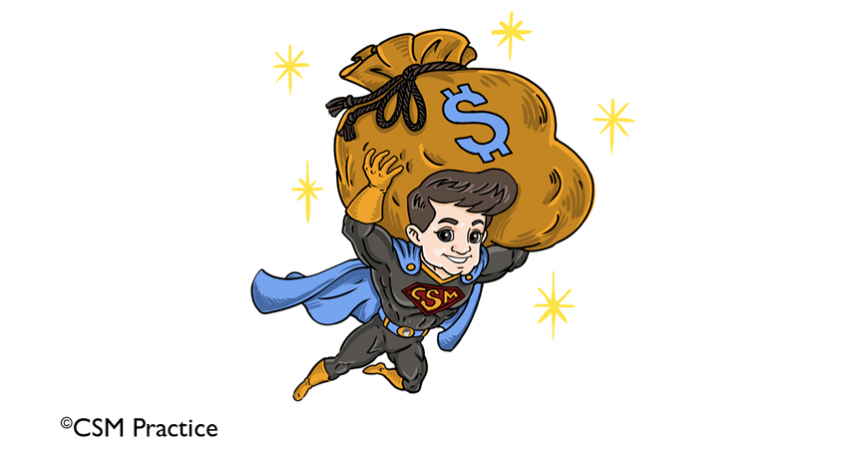

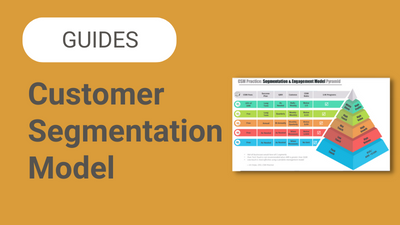
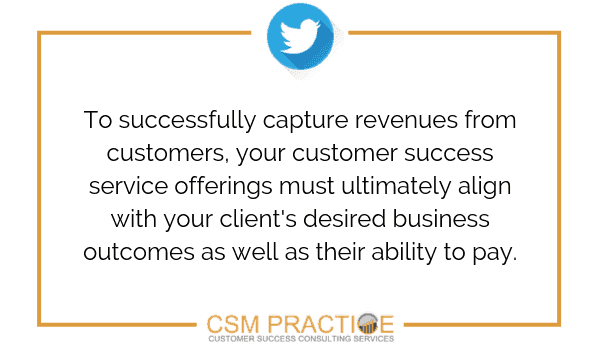
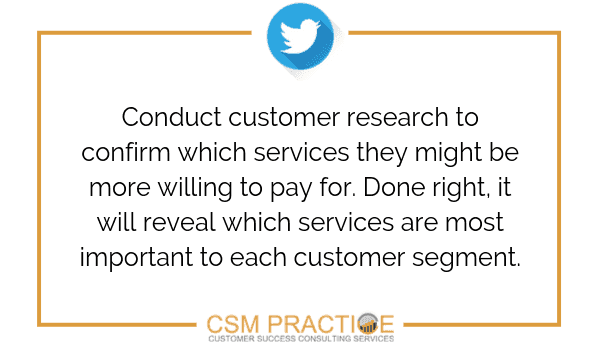
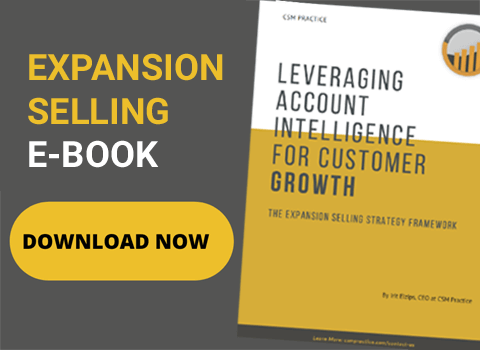
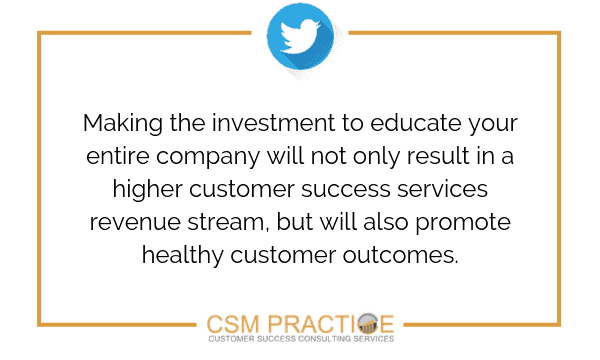
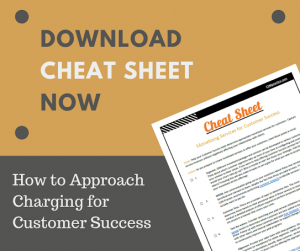
February 19, 2020
Glad you like it 🙂 Please consider sharing it with others if you find this content helpful.
October 30, 2020
I pay a visit day-to-day some blogs and information sites to read content, but this webpage gives feature based posts.